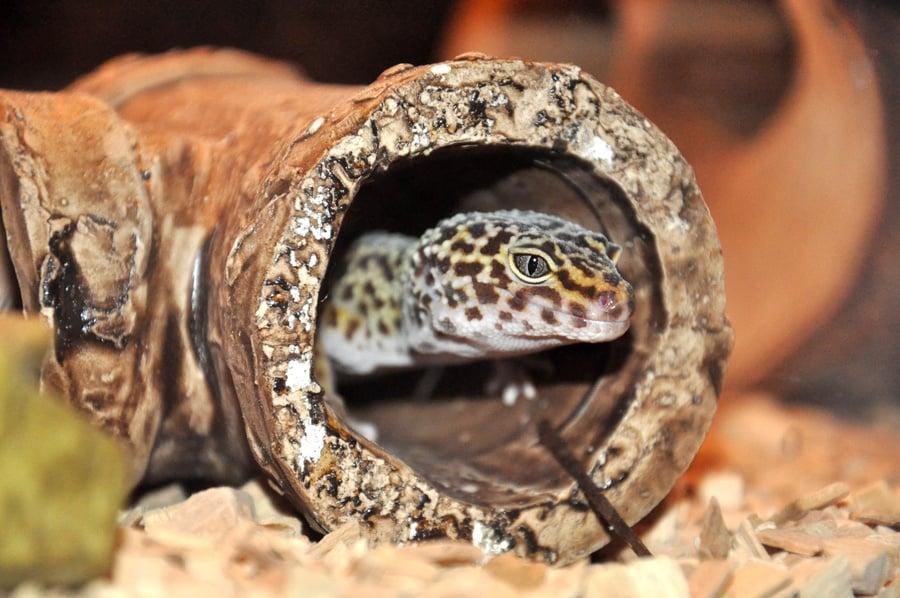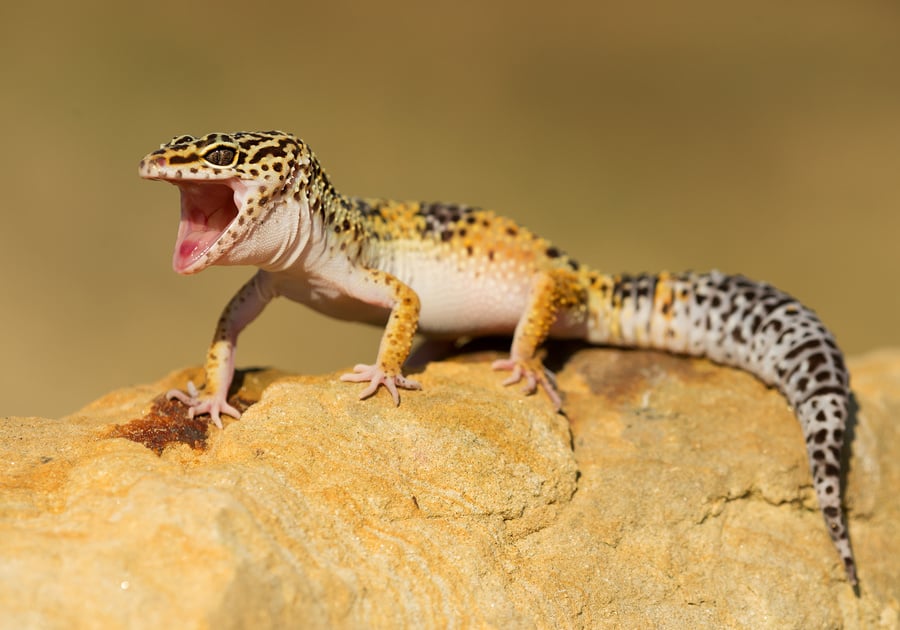As a leopard gecko owner, it’s important to understand the guidelines for cohabitation amongst these fascinating creatures. Leopard geckos are naturally solitary animals and prefer to live alone. Keeping multiple geckos together can lead to aggression, fighting, and potential injuries.
Key Takeaways:
- Leopard geckos are naturally solitary and should not be kept together in the same enclosure.
- Male and male or female and female cohabitation can lead to aggression and fights.
- Male and female leopard geckos can be housed together for breeding purposes if properly monitored.
- Introduce geckos to each other gradually and closely monitor their behavior to prevent stress or dominance.
- Consider enclosure size, resources, and temperature gradients when housing multiple geckos.

Leopard Gecko Cohabitation Guidelines
Male & Male Cohabitation
When it comes to leopard geckos, it’s important to understand that male and male cohabitation should be avoided. These creatures are naturally territorial and will exhibit aggressive behavior towards each other if housed together. To ensure the safety and well-being of each gecko, it is crucial to provide them with their own separate enclosures.
The aggression displayed by male leopard geckos towards each other can lead to fights and potentially serious injuries. By giving each gecko its own space, you are minimizing the risk of harm and allowing them to thrive individually. Each gecko should have a properly sized enclosure that includes hiding spots, temperature gradients, and feeding areas.
By following these guidelines and keeping male geckos separate, you are providing the best environment for their physical and emotional health. Male leopard geckos are better off as solitary creatures, and their individual needs are better met when they have their own space.
| Benefits of Separate Enclosures for Male Leopard Geckos |
|---|
| Minimizes aggressive behavior and fights |
| Prevents potential injuries |
| Promotes individual well-being |
| Allows for proper temperature and habitat control |
Female and Female Cohabitation
When it comes to leopard geckos, female and female cohabitation is possible under the right circumstances. These social creatures can generally be housed together without major issues if proper introduction and monitoring are implemented. However, it is important to note that not all female leopard geckos will get along, so close observation of their behavior is crucial to ensure their well-being.
One key factor to consider when introducing female leopard geckos is their size. Selecting females of similar size can help minimize bullying and potential conflicts. It is also recommended to provide multiple hiding spots and feeding areas within the enclosure to prevent competition for resources. Additionally, it is essential to closely monitor their behavior for any signs of aggression or dominant behavior. If any negative interactions are observed, it is best to separate the geckos to prevent stress and potential harm.
For a complete breakdown of leopard gecko social behavior, check out this guide. Read this article to learn about leopard gecko dominance behavior. Read this article to learn about leopard gecko stress indicators.
It is important to remember that even with compatible female leopard geckos, each individual has its own unique personality and temperament. Therefore, it is crucial to provide adequate space and environmental enrichment to ensure the well-being of each gecko. Regular monitoring and assessment of their interactions will help create a harmonious cohabitation environment for female leopard geckos.
| Pros of Female and Female Cohabitation | Cons of Female and Female Cohabitation |
|---|---|
| Opportunity for socialization and companionshipPotential for reduced stress levelsCan observe natural behaviors and interactions | Possible conflicts and aggressionRisk of dominant behavior and bullyingIndividual geckos may have incompatible personalities |
Male and Female Cohabitation: Best Practices for Gecko Tank Mates
When considering housing male and female leopard geckos together, it is crucial to follow certain guidelines to ensure their safety and well-being. Here are some best practices for cohabitating male and female geckos:
- Monitor the size and age difference: The male and female geckos should ideally be of similar sizes to prevent the male from overpowering or causing harm to the female during breeding attempts. It is also important to consider the age difference, as mature females can experience stress or health issues if repeatedly bred.
- Provide separate hiding spots: Although the geckos are living together, it is essential to provide multiple hiding spots within the enclosure. This allows the female a chance to retreat if she feels overwhelmed or desires privacy during breeding cycles.
- Supervise breeding attempts: Breeding should only be attempted by experienced owners who can closely monitor the male and female geckos during mating. If aggression is observed or the female shows signs of stress, it is advisable to separate them to prevent injuries or health complications.
- Offer ample food and water: Ensure that each gecko has access to sufficient food and water sources within the enclosure. Feeding both geckos separately can help prevent competition for resources and reduce the chances of aggression.
By following these best practices, you can increase the chances of successful cohabitation between male and female leopard geckos. However, it is important to note that breeding should only be pursued with careful consideration and in the best interest of the geckos’ health.
| Pros of Male and Female Cohabitation | Cons of Male and Female Cohabitation |
|---|---|
| Opportunity for successful breeding | Increased risk of aggression and fighting |
| Observing natural reproductive behaviors | Potential stress and health issues for the female |
| Possible bonding between the geckos | Inadequate monitoring can lead to injuries |
Remember, every leopard gecko has its own personality, and not all individuals will be compatible for cohabitation. It is essential to closely observe their behavior and separate them if necessary to ensure their well-being. If you are unsure about housing male and female geckos together, it is recommended to keep them in separate enclosures to prevent any potential conflicts or harm.
Considerations for Cohabitation
When considering cohabitation of multiple leopard geckos, there are several important factors to take into account. These include the relationship and history between the geckos, the size of the enclosure, and the availability of resources. By carefully considering these aspects, you can create a harmonious living environment for your geckos.
The first factor to consider is the relationship and history between the geckos. If they have been housed separately for a long period of time, introducing them to a shared enclosure can be stressful and potentially lead to aggression. In such cases, it is recommended to gradually introduce the geckos to each other in a neutral environment and closely monitor their behavior.
Another important consideration is the size of the enclosure. Providing enough space is crucial to prevent conflicts and territorial behavior. As a general guideline, allow at least 10 gallons of space for each gecko. This will ensure that each gecko has enough room to establish their own territory and reduces the likelihood of competition for resources.
| Considerations for Cohabitation | Recommendations |
|---|---|
| Relationship and history between the geckos | Gradually introduce geckos in a neutral environment and monitor behavior |
| Size of the enclosure | Allow at least 10 gallons of space per gecko |
| Availability of resources | Provide multiple hiding spots, feeding areas, and water dishes |
Lastly, ensure that there are enough resources available for all geckos in the enclosure. This includes providing multiple hiding spots, feeding areas, and water dishes. By offering sufficient resources, you can minimize competition and reduce the likelihood of conflicts.
Overall, if you decide to house multiple leopard geckos together, it is important to consider their relationship, provide an adequately-sized enclosure, and ensure the availability of resources. By taking these considerations into account, you can create a safe and comfortable living environment for your geckos.
Enclosure Size and Requirements
When housing multiple leopard geckos together, it is crucial to provide them with a suitable enclosure size to ensure their comfort and well-being. The size of the tank plays a significant role in creating a spacious and stress-free environment for the geckos. As a general rule, it is recommended to add five gallons to the tank size for each additional gecko. This allows for ample space for each gecko to roam, explore, and establish their territories.
A larger enclosure not only provides more room for the geckos but also allows for better temperature gradients. Leopard geckos require specific temperature zones within their habitat to regulate their body temperature effectively. In a larger enclosure, it is easier to create these temperature gradients by placing heat sources in different areas. This ensures that each gecko can find the optimal temperature zone that suits their needs.
In addition to size, the enclosure should also include multiple hiding spots and water dishes. These provide essential resources for the geckos, allowing them to have their own designated areas for shelter and hydration. Hiding spots should be placed strategically throughout the enclosure to prevent competition or conflicts between geckos. Water dishes should be easily accessible and placed in different areas to avoid territorial disputes.
Table: Recommended Enclosure Sizes for Multiple Leopard Geckos
| Number of Geckos | Minimum Tank Size (Gallons) |
|---|---|
| 1 | 20 |
| 2 | 25 |
| 3 | 30 |
| 4 | 35 |
| 5 | 40 |
It is important to note that these recommended enclosure sizes are a starting point and should be considered as the minimum requirement. Providing larger tanks when possible will further enhance the living conditions for the geckos, reducing the risk of stress, territorial disputes, and potential aggression. Ensuring a spacious and well-equipped enclosure is essential for the overall health and happiness of multiple leopard geckos living together.
Compatibility with Other Lizard Species
When considering cohabitation options for leopard geckos, it is important to take into account their compatibility with other lizard species. While some reptiles may seem like potential tank mates, it is crucial to understand their specific needs and behaviors to ensure a successful cohabitation.
Compatible Gecko Species for Cohabitation
Leopard geckos are not typically compatible with other lizard species for cohabitation due to differences in enclosure conditions and temperature requirements. Although certain gecko species, such as crested geckos or bearded dragons, may share some similarities with leopard geckos, their housing needs and behaviors differ significantly.
Leopard geckos are primarily ground-dwelling reptiles, while species like crested geckos are arboreal. This difference in habitat preferences can lead to conflicts and stress when sharing an enclosure. Additionally, leopard geckos require a specific temperature range for optimal health, which may not align with the needs of other lizard species.
Considering these factors, it is generally best to house leopard geckos alone to prevent conflicts and ensure their well-being. In the case of cohabitation, it is crucial to thoroughly research and consult with reptile experts before attempting to house leopard geckos with other lizard species.
| Species | Compatibility with Leopard Geckos |
|---|---|
| Crested Geckos | Not recommended due to different habitat preferences and temperature requirements. |
| Bearded Dragons | Not recommended due to differences in habitat preferences and temperature requirements. |
| Other Gecko Species | Not recommended due to potential conflicts and stress caused by mismatched behaviors and housing needs. |
For a successful and stress-free living environment, it is best to provide leopard geckos with their own dedicated enclosures, tailored to their specific needs. This ensures that they have the appropriate temperature, hiding spots, and feeding areas to thrive and remain healthy.
Cohabitation with Turtles
When considering cohabitation with turtles, it is important to carefully assess the size and requirements of the enclosure. While it is possible to house leopard geckos with turtles, certain factors should be taken into consideration to ensure the well-being of both species.
Turtle Enclosure Requirements
Turtles typically require a part of their habitat to be dedicated to water, which may limit the available space for the leopard geckos. It is important to provide enough dry land and ensure that the enclosure is large enough to accommodate both species comfortably. Providing hiding spots and basking areas for the turtles is crucial to meet their specific needs.
Leopard Gecko Compatibility
Leopard geckos are generally non-aggressive and can coexist with turtles peacefully. However, it is crucial to closely monitor their interactions to ensure that neither species is stressed or harmed. Leopard geckos should have their own hiding spots and adequate space away from the turtles to retreat to when needed. Feeding should also be managed separately to prevent competition and ensure that both species receive their required nutrients.
| Leopard Geckos | Turtles |
|---|---|
| Provide hiding spots | Provide ample dry land and hiding spots |
| Adequate space away from turtles | Ensure enough space for both species |
| Separate feeding areas | Manage feeding separately to prevent competition |
By following these guidelines, leopard geckos and turtles can potentially live harmoniously together. However, it is important to closely monitor their behavior and make adjustments as necessary to ensure the well-being of both species.

Cohabitation with Frogs
When considering tank mates for leopard geckos, frogs can be a potential option if the right species are chosen. It is important to select diurnal frogs that have opposite schedules from leopard geckos to minimize interaction and potential conflicts. Poison dart frogs and mantella frogs are commonly successful options for cohabitation.
Table: Compatible Frog Species for Leopard Gecko Tank Sharing
| Frog Species | Compatibility |
|---|---|
| Poison Dart Frogs | Compatible – but ensure the species selected does not secrete toxins harmful to other reptiles |
| Mantella Frogs | Compatible – monitor behavior closely for any signs of aggression |
When introducing frogs to a leopard gecko enclosure, it is advisable to choose smaller frog species to minimize the risk of predation. Additionally, providing adequate hiding spots and separate feeding areas for both frogs and geckos is essential to prevent competition and stress. By carefully selecting compatible species and closely monitoring their behavior, leopard gecko and frog cohabitation can be a successful and visually engaging addition to an enclosure.
Conclusion
After careful consideration, it is evident that cohabitation of leopard geckos should be approached with caution. These naturally solitary creatures have a tendency towards aggression and territorial behavior when housed together, whether it’s male and male, female and female, or male and female. While it is possible to keep a male and female together for breeding purposes, it should only be done by experienced owners who can provide proper monitoring and care.
Keeping leopard geckos alone is generally recommended to ensure their well-being and prevent potential injuries or stress. However, if you do decide to house multiple geckos together, it is crucial to consider factors such as gender, size, and compatibility. Slow and gradual introductions are essential, as well as providing enough space, hiding spots, and feeding areas for each gecko.
To keep multiple leopard geckos happy and healthy, it is vital to closely monitor their behavior and separate them if any signs of aggression or dominant behavior arise. Additionally, providing a spacious enclosure with appropriate temperature gradients, multiple hiding spots, and water dishes is crucial. Remember, breeding should only be attempted by experienced owners, as it can have potential health implications for the female gecko.
FAQ
Can male and female leopard geckos be housed together?
Yes, male and female leopard geckos can be housed together, but this should only be done if breeding is planned and if experienced owners are overseeing the process.
What factors should be considered when cohabitating leopard geckos?
Factors such as the relationship and history between the geckos, enclosure size, and available resources need to be taken into account when considering cohabitation.
How large should the enclosure be when housing multiple leopard geckos?
It is recommended to add five gallons to the tank size for each additional gecko, and providing multiple hiding spots and water dishes is essential in larger enclosures.
Can leopard geckos be housed with other lizard species?
No, leopard geckos are not typically compatible with other lizard species for cohabitation due to differences in enclosure conditions and temperature requirements.
Can leopard geckos be housed with turtles?
Yes, it is possible to house leopard geckos with turtles, but the size of the enclosure needs to be considered to accommodate both species comfortably.
Can leopard geckos be housed with frogs?
Yes, certain frog species can be potential companions for leopard geckos, but careful consideration of compatibility and avoiding toxic frog species is necessary.
